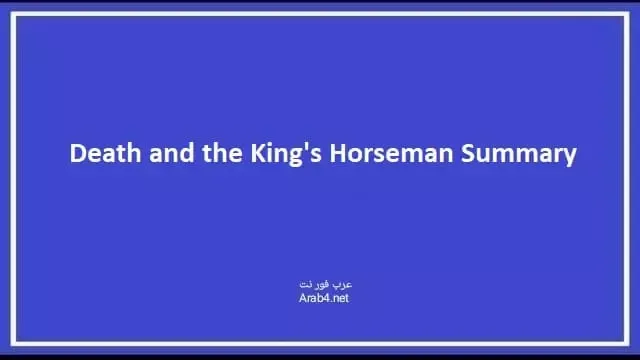Death and the King's Horseman Summary, it is a play by Wole Soyinka based on a real incident that took place in Nigeria during the colonial era: the horseman of a Yoruba King was prevented from committing ritual suicide by the colonial authorities. In addition to the intervention of the colonial authorities, Soyinka calls the horseman's own conviction toward suicide into question, posing a problem that throws off the community's balance.
Soyinka wrote the play in Cambridge, where he was a fellow at Churchill College during his political exile from Nigeria. He has also written a preface to the play, explaining what he sees as the greatest misconceptions in understanding it. In particular, he says that the play should not be considered as "clash of cultures." Rather, the play demonstrates the need for interaction between African and European cultures, as per Soyinka's post-Biafran cultural philosophy.
 |
| Death and the King's Horseman Summary |
Death and the King's Horseman Summary
Act 1 : Elesin and his praise-singer enter the market discussing Elesin’s love for women and his journey to commit ritual suicide. While interacting with the women of the market, Elesin spots a beautiful young woman. Elesin states his wish to marry the young woman and the women give him permission as it is his last day and they don’t wish to disturb the order of the world. Iyaloja and the praise-singer warn Elesin not to become too attached to the world.
Act 2 : Jane and Simon Pilking, the district officer, are preparing for a ball when Amusa tells them that Elesin is planning to die.. Simon and Jane discuss how serious the matter is but ultimately decide to attend the ball. Simon sends word to Amusa to arrest Elesin.
Act 3 : Back at the market, Amusa confronts the women of the market who are blocking him from arresting Elesin. They verbally taunt him and his constables and tell him he is not welcomed in the market. Amusa leaves at Iyaloja’s command and Elesin appears from the stall. He rejoices that his bride was a virgin and that he will leave the world with a child. The drumming increases as the king’s dog and horse are killed. Elesin begins dancing with the women as death approaches.
Act 4 : At the ball, attended by the prince of England, Amusa sends word to Simon that he needs help in the market. As the men leave to deal with the situation, Jane spots Olunde, Elesin’s son who has returned from England where he was studying to become a doctor. Olunde and Jane discuss the honor of dying for others in detail. Pilking arrests Elesin, stopping him from committing suicide, and puts him in the old slave cellar.
Act 5 : Elesin, standing in the cellar chained, discusses what Simon has done to the Yoruba people by stopping the suicide. Sion tells Elesin his son wishes to visit him but Iyaloja comes first to speak with him. A group of chanting women wishes to be let in, Simon lets them in. They bring with them Olunde’s dead body. Olunde took his father’s place. At the sight of his son, Elesin commits suicide with his chains. Iyaloja tells Simon that this is his fault and then tells Elesin’s bride that she should think upon the unborn, not the living or dead.
You may also like to read: Alice in Wonderland Book Summary
Questions about Death and the King's Horseman Plot
What is the message of death and the king's horseman? Some of his plays are pointed at corrupt African leaders, but plays such as Death and the King's Horseman examines the culture in Nigeria at the time and its weakness, forgetfulness of traditions, and lack of duty.
What is the main conflict of death and the king's horseman? Wole Soyinka's play Death and King's Horseman reflects the cultural conflict between the African and Western worlds. The play is based on an actual event that took place in 1946 when British colonial authorities prevented the customary ritual suicide from taking place.
Who is the character of Death and the Kings Horseman? Elesin Oba, the king's horseman, is the main character in the play. Part of his duty as the king's horseman is to commit suicide following the king's death. As the play begins, it has been one month since the death of the king.
What is the theme of colonialism in Death and the King's Horseman? the action of Death and the King's Horseman becomes less about one man's failure to uphold his society's traditions and maintain cosmic order—instead, Elesin and Olunde's deaths come to symbolize the death of the Yoruba society as a whole under colonial rule.
What is the conclusion of the death and the king's horseman? some men bring in a package, and it turns out to be Olunde's body; it seems he has sacrificed himself to try to take his father's place in the ritual. Elesin is devastated, so he strangles himself with the chains binding him before the authorities can react.
What is the significance of the title Death and the King's Horseman? signifies that he's in service to the king and shares many of the same rights and perks, but without the same responsibilities.
What type of tragedy is Death and the King's Horseman? Abstract. Wole Soyinka's Death and the King's Horseman has been widely acclaimed as a great example of African tragedy. It is, in fact, the dramatic aggregation of Soyinka's treatise in Myth, Literature and the African World.
What is the climax of the death and the king's horseman? The king has died and Elesin, his chief horseman, is expected by law and custom to commit suicide and accompany his ruler to heaven. The stage is set for a dramatic climax when Pilkings learns of the ritual and decides to intervene and Elesin's son arrives home.
